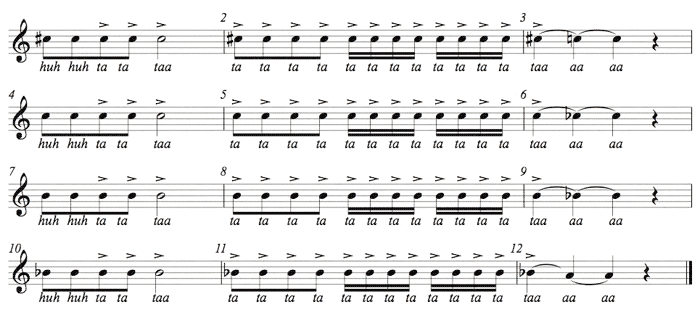Sep 13

Saxophone Tone Development
by Phil Barone
The point of these two exercises is to learn to play a saxophone without using the muscles in your face, to use the jaw muscles and to be as loose as possible, allowing the reed to vibrate at its maximum. After I did these for several months, I found that I no longer needed a high-baffle mouthpiece to get a funky or really loud sound because my embouchure was no longer getting in the way of the reed. In fact, when I tried to use a high-baffle mouthpiece it was way too bright. Granted, I don't sound quite as loud as I would with a high-baffle piece but darn close and I get a much higher quality sound.
You want your embouchure to remain stable and unmoving and you should put one inch (24 mm) or a little more of the mouthpiece in your mouth so that your bottom teeth are just past where the facing begins to curve on the side-rails of your mouthpiece. That means you want your bottom teeth to go in a little more than one inch; the facing on most tenor mouthpieces starts to break away (called the break) of the side rails at a little less than one inch. So by bringing the mouthpiece in an inch no matter how much you bite or how tight your facial muscles are you won't close the tip opening off which allows for the reed to vibrate the full width of the tip opening. Any less and you'll bend the reed which will cause the pitch to change and won't give you the complete benefit of the tip openings size and the sound the mouthpiece is capable of producing.
For some people using high-baffle mouthpieces, they may unconsciously do this to adjust the sound down and if you play a high-baffle mouthpiece now you may find that after you've been doing these exercises a couple of weeks that you no longer need a high-baffle piece because you will get a much larger variety of tonal colors. You may also find that you no longer need harder reeds because you're no longer closing off the tip-opening.
When you first start to do this you may find the sound obnoxious or unrefined, but your ear will take over and this will go away in several days at the most. You will be left with much more volume and control, with the exception of the altissimo notes which you will no longer play by manipulating or bending the reed. After you get good at exercise one, you should be able to get altissimo notes out by making small adjustments in the muscles at the front of your throat. That's how Lennie Pickette, Ernie Watts, Sonny Rollins does it and that's how Mike Brecker did it so if they did it so can you.
Read this entire post before starting exercises one.
Exercise One
Finger low F but sound middle F by slightly over-blowing and be sure to feel the muscles in your stomach when you blow. When you take a breath your stomach should come out instead of your shoulders going up. Using the muscles in the upper, front part of your throat, "slide" it down to low F. It's a subtle movement so it takes some time to get in touch with these muscles because you may not have ever used them. Before you attempt it remember that the pressure on the reed should just be enough to FEEL the reed through your bottom lip with your teeth using the same muscles you'd use to chew your food, not your facial muscles. You should never use facial or lip muscles. This is crucial.
You will feel this subtle movement in the lower part of your throat if you're doing it correctly when the octave drops to low F. There's no rhythm so hold the note for as long as you have to until it sounds low F but do it with the air stream while opening your throat and supporting your diaphragm. Be patient with yourself because you're doing something new and may take a little time. One way for you to understand how to make it happen and experience the feeling in your throat is to take a deep breath and when you run out of air the low F will sound naturally.
Just keep blowing until you run out of air and the low F sounds but remember to be aware of the front part of your throat. Pay close attention to what's happening and once you get it you'll be able to do it on command.
Now, once you begin to get it, it will most likely be sloppy, you may hear squeaks and other sounds in between the first F and the low F so work on making it clean but don't use your embouchure to drop to the lower octave. If there's a gurgle or some distortion in between the middle F and low F that means you need to use more air or more consistent air but keep trying it until its CLEAN and PRECISE. Use your diaphragm, open your throat and relax more as you go to the low F keeping the diaphragm supported.
Do this exercise chromatically down to low Bb. It gets harder as you go down but the benefits will come by just practicing it, not by perfecting it. As you go further down on your instrument I suggest you return to the previous notes like F. If you're working on B you may want to practice C for a little while because you may have to re-experience the sensation to make it happen on lower notes.
You should probably do it on F and E before you venture further down the register but trying to do it on D or Eb won't hurt because it's harder and may give you some insight on how to do it on D flat for example. If you're not successful then stop and take a break because you don't want to reinforce bad habits and the worst thing that can happen is if you start feeling tightness around your embouchure because that exactly what we're trying to avoid. And remember, these exercises are just for warming up and cooling down and should not be done for too long.
This is part II of the tone production exercises I learned from Joe Allard and Victor Morosco with embellishments by myself but the credit really belongs to Joe and Victor who really revolutionized the way the saxophone and clarinet should be played with regard to the embouchure. From a mouthpiece makers perspective it's completely and utterly ridiculous that anyone would play any other way such as with a tight embouchure while not taking less than an inch of mouthpiece in the player's mouth. Evidence of this is apparent by looking at photos of John Coltrane, Sonny Rollins, Michael Brecker and virtually ALL of the greatest players of all time. While there may be exceptions. Ernie Watts is up past the biteplate on his mouthpiece and so is Sonny Rollins and Mike Brecker used to play way up there too and Mike and Ernie were both studio players and played every genre of music so don't let anyone tell you that you can only play certain ways or a particular style using this method.
Another great exercise is to purchase a very large tip opening mouthpiece to warm up on and do these exercises and to teach you to use your diaphragm completely. However, you can do more harm than good if you use a hard reed on a very open mouthpiece and it may cause you to become tight. Just remember not to bite or use too much pressure on the mouthpiece, you must blow harder on a more open mouthpiece to set it the reed in motion.
Contrary to popular belief, the saxophone is best played with a very loose embouchure in order to let the reed "float". I've studied the Larry Teal method which is very different and having made mouthpieces for so long I believe the Allard method is best. There will always be some tightness and jaw movement no matter what you do and there have been plenty of players that didn't subscribe to this method that sounded great but there are many variables and nothing is unequivocal, especially in art where anything can go and who's to say how these few may have sounded had they embraced the Allard method. Maybe a lot better.
I'll add that it's not necessary to get obsessed with these exercises but try to do them correctly and put in a few minutes to warm up and a few minutes to cool down each day.
Points to Remember
- Remember that you can't take too much mouthpiece in within reason. You shouldn't choke but try to pass the point that the facing starts on the rails of the mouthpiece, an inch for tenor, and 3/4 for alto. That's the teeth should be past that, not the lips. At first, this will be uncomfortable and the sound may be crass and hard to control but be mindful and you will persevere. The crassness will go away in a few days or less.
- The only pressure on the reed should be with the bottom teeth through the lip USING THE JAW MUSCLES, NOT THE MUSCLES IN YOUR FACE. It should just be enough to FEEL the reed through the lower lip. Any more than that and you begin to close the tip opening of the mouthpiece off.
- If you're playing loud or soft you should always be filling the same amount of air through the sax but when you're playing loud you're moving the air through the sax faster and when you're playing softly you're moving the air through slowly.
Whether this is true or not I honestly don't know, it's just a metaphor to enable you to be able to always fill the saxophone up with air all the time. Always imagine your horn being full of air whenever you're playing and you'll always have a fuller, bigger sound.
Exercise Two

The first part or section is all open C# until the end when you slur down to C natural. This is the whole exercise and you'll just be continuing down chromatically. The syllable HUH is used with no tongue and the syllable TA is a fast hard staccato. You should be blowing hard using your diaphragm as you blow. Always use a metronome at a slow to medium speed. OPEN C# FOR TWO EIGHTH NOTES FOLLOWED BY TWO STRONG STACCATO EIGHTHS FOLLOWED BY ONE STRONG STACCATO HALF NOTE etc.
Points to Remember
Remember, the term "loose" is used loosely. If you play too loosely then the horn would come out of your mouth. Here are a couple of tips for all the exercises. Take as much mouthpiece as reasonably possible. This will force you to loosen up and don't "try" to play the high notes. From now on you're going to use your throat so start getting in touch with your throat muscles. If you start using your throat instead of the muscles in your face you'll be able to get a series of different notes without changing your fingering.
Any pressure on the reed should just be enough to FEEL the reed through your bottom lip with your teeth, no more. You never use facial or lip muscles, use the same muscles you would use to chew your food.
Start experimenting with that and keep the airflow CONSTANT when playing both exercises especially the first one. Just do F first and keep the air flowing until it transcends to low F etc. and at first it make take a few seconds to drop down but notice the subtle changes in your throat. In no time once you feel what's happening in your throat you'll be able to do it at will. It's normal that the low notes are especially hard with both of these exercises but the benefit comes with TRYING to do them, not by necessarily actually doing them but the better they get is indicative of your progress. Lastly, start playing scales on just your mouthpiece when you're in your car and places like that where you can't have the horn.
Length of tenor facing- 1 inch = 25.4 millimeters Length of alto facing-.750 inches= 19.05 millimeters.


